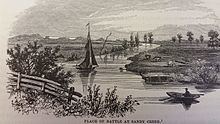13 killed140 captured (30 of whom were wounded) 2 wounded Result American victory | Dates 29 May 1814 – 30 May 1814 Location Sandy Creek | |
 | ||
Similar Battle of Fort Oswego, Battle of Lacolle Mills, War of 1812, Skirmish at Farnham Church, Siege of Fort St Philip | ||
Wcny minute war of 1812 the battle of big sandy creek the great rope carry
The Battle of Big Sandy Creek was fought in northwestern New York on May 29–30, 1814, during the War of 1812. The battle was an American victory in which American militia and Oneida Indians launched a surprise attack on British soldiers who were chasing them inland from Lake Ontario.
Contents
- Wcny minute war of 1812 the battle of big sandy creek the great rope carry
- Battle of big sandy creek
- Background
- Battle
- Losses
- References
Battle of big sandy creek
Background
After the successful attack on Fort Oswego on May 5–6, 1814, the British withdrew to the Galloo Islands in northern Lake Ontario where they could monitor and intercept any supplies on their way north to Sackets Harbor, New York. At the American ship yards in Sackets Harbor, two brigs, the USS Jefferson and the Jones, and a frigate, the Superior, waited for armament and rigging necessary for their launch. The supplies needed to outfit the ships had been transported from the Brooklyn Naval Yards on Long Island to Albany, New York, and from Albany up the Mohawk River to Wood Creek and Oneida Lake, finally arriving at the Oswego River. These supplies still needed to be transported from Oswego to Sackett’s Harbor, but it needed to be done without alerting the British.
On April 21, 1814, Commodore Isaac Chauncey sent orders from Sackets Harbor to Lieutenant Melancthon Taylor Woolsey directing him to choose five officers and twenty-five men to proceed in the USS Lady of the Lake to Oswego and then bring the shipbuilding supplies north to the shipyards.
Battle
On the rainy evening of May 28, Woolsey set out with 150 riflemen under the command of Major Daniel Appling in 19 boats loaded with supplies. On the morning of May 29, they arrived at the mouth of the Big Salmon River having mysteriously lost one of their boats. This boat, discovered by the British forces, eliminated the secrecy of Wooley’s mission.
At Big Salmon, the American forces met up with the Oneidas (estimates range from 120 to 130 Indians), who Woolsey had dispatched the previous day. The Oneidas marched north along the shore as the boats proceeded in the lake. At noon on May 29, they reached the mouth of the Big Sandy Creek. All the boats were sent as far inland as possible.
Woolsey then sent a lookout to scout for British ships. The lookout discovered that a gunboat and three barges were headed for the location of the American forces. Woolsey set out a call for the neighboring militia and hastily prepared for battle.
At 8 a.m., the British began to cannonade the American forces from the mouth of the Big Sandy Creek. The American forces hid along the shoreline of the creek and waited for the British to advance inland. At about 10 a.m., when the British forces had progressed up the creek, the American forces rose from their concealment, and a brief ten-minute battle ensued. The British officers quickly surrendered to avoid further casualties.
Losses
The Americans suffered 2 wounded: an Oneida Indian and a U.S. rifleman. Appling wrote to Brigadier General Edmund P. Gaines on May 30, listing the British casualties as 13 killed; 2 lieutenants of the Royal Marines and 28 sailors and marines wounded and captured; 7 officers and 133 others taken prisoner. Also captured were three gun-boats (one with a 24-pounder and a 63-pounder), two cutters and one gig.
